Moroccan architecture
Moroccan architecture refers to the architecture characteristic of Morocco throughout its history and up to modern times. The country's diverse geography and long history, marked by successive waves of settlers through both migration and military conquest, are all reflected in its architecture. This architectural heritage ranges from ancient Roman and Berber sites to 20th-century colonial and modern architecture.
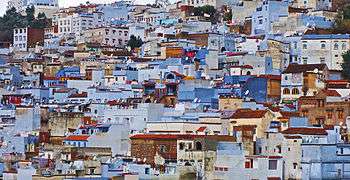
The most recognizably "Moroccan" architecture, however, is the traditional architecture that developed in the Islamic period (7th century and after) which dominates much of Morocco's documented history and its existing heritage.[1][2] This "Islamic architecture" of Morocco was part of a wider cultural and artistic complex, often referred to as "Hispano-Moorish" art, which characterized Morocco, al-Andalus (Muslim Spain and Portugal), and parts of Algeria and even Tunisia.[3][2][4][5] It blended influences from Berber culture in North Africa, pre-Islamic Spain (Roman, Byzantine, and Visigothic), and contemporary artistic currents in the Islamic Middle East to elaborate a unique style over centuries with recognizable features such as the "Moorish" arch, riad gardens (courtyard gardens with a symmetrical four-part division), and elaborate geometric and arabesque motifs in wood, stucco, and tilework (notably zellij).[3][2][6][7]
.jpg)
Although Moroccan Berber architecture is not strictly separate from the rest of Moroccan architecture, many structures and architectural styles are distinctively associated with traditionally Berber or Berber-dominated regions of Morocco such as the Atlas Mountains and the Sahara and pre-Sahara regions.[8] These mostly rural regions are marked by numerous kasbahs (fortresses) and ksour (fortified villages) shaped by local geography and social structures, of which one of the most famous is Ait Benhaddou.[9] They are typically made of rammed earth and decorated with local geometric motifs. Far from being isolated from other historical artistic currents around them, the Berbers of Morocco (and across North Africa) adapted the forms and ideas of Islamic architecture to their own conditions and in turn contributed to the formation of Western Islamic art, particularly during their political domination of the region over the centuries of Almoravid, Almohad, and Marinid rule.[7][8]
Modern architecture in Morocco includes many examples of early 20th-century Art Deco and local neo-Moorish (or Mauresque) architecture constructed during the French (and Spanish) colonial occupation of the country between 1912 and 1956 (or until 1958 for Spain).[10][11] In the later 20th century, after Morocco regained its independence, some new buildings continued to pay tribute to traditional Moroccan architecture and designs, as exemplified by the massive Hassan II Mosque in Casablanca completed in 1993.[12] Modernist architecture is also evident in contemporary constructions, not only for regular everyday structures but also in major prestige projects.[13][14]
History
From Antiquity to early Islamic period (up to 10th century)
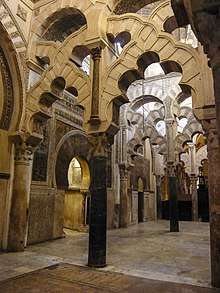

Although less well-documented, Morocco's earliest historical periods were dominated by the indigenous Berber populations (still present today), up to the Berber kingdoms of Mauretania.[15] Roman occupation and settlement was much less extensive than in other nearby regions like Hispania or "Africa" (Tunisia) but nonetheless left notable sites such as Volubilis, which acted as an important early urban center.[1][16]
In the early 8th century the region became steadily integrated into the emerging Muslim world, beginning with the military incursions of Musa ibn Nusayr and becoming more definitive with the advent of the Idrisid dynasty at the end of that century.[16] The arrival of Islam was extremely significant as it developed a new set of societal norms (although some of them were familiar to Judeo-Christian societies) and institutions which therefore shaped, to some extent, the types of buildings being built and the aesthetic or spiritual values that guided their design.[17][18][19][20]
The Idrisids founded the city of Fes, which became their capital and the major political and cultural center of early Islamic Morocco.[1][21] In this early period Morocco also absorbed waves of immigrants from Tunisia and al-Andalus (Muslim-ruled Spain and Portugal), who brought in cultural and artistic influences from their home countries.[16][4] The earliest well-known Islamic-era monuments in Morocco, such as the al-Qarawiyyin and Andalusi mosques in Fes, were built in the hypostyle form and made early use of the horseshoe or "Moorish" arch.[3][22] These reflected early influences from major monuments like the Great Mosque of Kairouan and the Great Mosque of Cordoba.[7] In the 10th century much of northern Morocco came directly within the sphere of influence of the Ummayyad Caliphate of Cordoba, with competition from the Fatimid Caliphate further east.[16] Early contributions to Moroccan architecture from this period include expansions to the Qarawiyyin and Andalusi mosques and the addition of their square-shafted minarets, anticipating the later standard form of Moroccan minarets.[22][3]
The Berber Empires: Almoravids, Almohads and Marinids (11th-15th centuries)
.jpg)
.jpg)
The collapse of the Cordoban caliphate in the early 11th century was followed by the significant advance of Christian kingdoms into Muslim al-Andalus and the rise of major Berber empires in Morocco. The latter included first the Almoravids (11th-12th centuries) and then the Almohads (12th-13th centuries), both of whom also took control of remaining Muslim territory in al-Andalus, creating empires that stretched across large parts of western and northern Africa and into Europe.[7] This period is considered one of the most formative stages of Moroccan and Moorish architecture, establishing many of the forms and motifs that were refined in subsequent centuries.[3][23][7][24] These two empires were responsible for establishing a new imperial capital at Marrakesh and the Almohads also began construction of a monumental capital in Rabat. The Almoravids adopted the architectural developments of al-Andalus, such as the complex interlacing arches of the Great Mosque in Cordoba and of the Aljaferia palace in Zaragoza, while also introducing new ornamental techniques from the east such as muqarnas ("stalactite" or "honeycomb" carvings).[23][25] The Almohad Kutubiyya and Tinmel mosques are often considered the prototypes of later Moroccan mosques.[23][3] The monumental minarets (e.g. the Kutubiyya minaret, the Giralda of Seville, and the Hassan Tower of Rabat) and ornamental gateways (e.g. Bab Agnaou in Marrakesh, and Bab Oudaia and Bab er-Rouah in Rabat) of the Almohad period also established the overall decorative schemes that became recurrent in these architectural elements thenceforth. The minaret of the Kasbah Mosque of Marrakech was particularly influential and set a style that was repeated, with minor elaborations, in the following Marinid period.[26][23][3]
.jpg)
The Berber Marinid dynasty that followed was also important in further refining the artistic legacy established by their predecessors. Based in Fes, they built monuments with increasingly intricate and extensive decoration, particularly in wood and stucco.[3] They were also the first to deploy extensive use of zellij (mosaic tilework in complex geometric patterns).[2] Notably, they were the first to build madrasas, a type of institution which originated in Iran and had spread west.[3] The madrasas of Fes, such as the Bou Inania, al-Attarine, and as-Sahrij madrasas, as well as the Marinid madrasa of Salé and the other Bou Inania in Meknes, are considered among the greatest architectural works of this period.[27][5][3] While mosque architecture largely followed the Almohad model, one noted change was the progressive increase in the size of the sahn or courtyard, which was previously a minor element of the floor plan but which eventually, in the subsequent Saadian period, became as large as the main prayer hall, and sometimes larger.[28]
The architectural style under the Marinids was very closely related to that found in the Emirate of Granada, in Spain, under the contemporary Nasrid dynasty.[3] The decoration of the famous Alhambra is thus reminiscent of what was built in Fes at the same time. When Granada was conquered in 1492 by Catholic Spain and the last Muslim realm of al-Andalus came to an end, many of the remaining Spanish Muslims (and Jews) fled to Morocco and North Africa, further increasing the Andalusian influence in these regions in subsequent generations.[5]
The Sharifian dynasties: Saadians and Alaouites (16th-19th centuries)
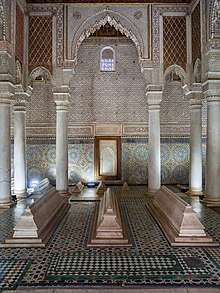

After the Marinids came the Saadian dynasty, which marked a political shift from Berber-led empires to sultanates led by Arab sharifian dynasties. Artistically and architecturally, however, there was broad continuity and the Saadians are seen by modern scholars as continuing to refine the existing Moroccan-Moorish style, with some considering the Saadian Tombs in Marrakesh as one of the apogees of this style.[28]
Starting with the Saadians, and continuing with the Alaouites (their successors and the reigning monarchy today), Moroccan art and architecture is portrayed by modern scholars as having remained essentially "conservative"; meaning that it continued to reproduce the existing style with high fidelity but did not introduce major new innovations.[3][26][28][2] Many of the mosques and palaces standing in Morocco today have been built or restored by the Alaouites at some point or another.[5][26][21] Ornate architectural elements from Saadian buildings, most famously from their lavish el-Badi Palace in Marrakesh, were also stripped and reused in buildings elsewhere during the reign of Moulay Isma'il (1672–1727).[28] Moulay Isma'il is also notable for having built a vast imperial capital in Meknes, where the remains of his monumental structures can still be seen today. Up until the late 19th century and early 20th century, the Alaouite sultans and their ministers continued to build beautiful palaces, many of which are now used as museums or tourist attractions, such as the Bahia Palace in Marrakesh or the Dar Batha in Fes.[2][11]
Modern and contemporary architecture: 20th century to present day

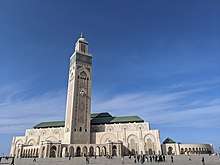
In the 20th century, Moroccan architecture and cities were also shaped by the period of French colonial control (1912-1956) as well as Spanish colonial rule in the north of the country (1912-1958). This era introduced new architectural styles such as Art Nouveau, Art Deco, and other modernist styles, in addition to European ideas about urban planning imposed by colonial authorities.[29] The European architects and planners also drew on traditional Moroccan architecture to develop a style sometimes referred to as Mauresque (a type of Neo-Moorish style), blending contemporary European architecture with a "pastiche" of traditional Moroccan architecture.[11][10] The French moved the capital to Rabat and founded a number of Villes Nouvelles ("New Cities") next to the historic medinas (old walled cities) to act as new administrative centers, which have since grown beyond the old cities. In particular, Casablanca was developed into a major port and quickly became the country's most populous urban centre.[16] As a result, the city's architecture became a major showcase of Art Deco and colonial Mauresque architecture. Notable examples include the civic buildings of Muhammad V Square (Place Mohammed V), the Cathedral of Sacré-Coeur, the Art Deco-style Cinéma Rialto, the Neo-Moorish-style Mahkamat al-Pasha in the Habous district.[11][30][31][32] Similar architecture also appeared in other major cities like Rabat and Tangier, with examples such as the Gran Teatro Cervantes in Tangier and the Bank al-Maghrib and post office buildings in downtown Rabat.[33][34][35] Elsewhere, the smaller southern town of Sidi Ifni is also notable for Art Deco architecture dating from the Spanish occupation.[36]

In the later 20th century, after Morocco regained its independence, and into the 21st century, contemporary Moroccan architecture also continued to pay tribute to the country's traditional architecture. In some cases, international architects were recruited to design Moroccan-style buildings for major royal projects such as the Mausoleum of Mohammed V in Rabat and the massive Hassan II Mosque in Casablanca.[37][12] The monumental new gates of the Royal Palace in Fez, built in 1969-1971, also made use of traditional Moroccan craftsmanship.[2] The new train stations of Marrakesh and Fes are examples of traditional Moroccan forms being adapted to modern architecture.[38] Modernist architecture has also continued to be used, exemplified by buildings like the Sunna Mosque (1966) and the Twin Center (1999) in Casablanca. More recently, some 21st-century examples of major or prestigious architecture projects include the extension of Marrakesh's Menara Airport (completed in 2008),[39] the award-winning High-Speed Train Station in Kenitra (opened in 2018),[40][41] the Finance City Tower in Casablanca (completed in 2019 and one of the tallest buildings in Morocco),[42] and the new Grand Theatre of Rabat by Zaha Hadid (due to be completed in late 2019).[43][44]
Influences
Amazigh
Structures such as agadirs (fortified granaries) and qsūr or qsars (fortified villages) are prominent traditional features of Amazigh architecture in Morocco.[45]
Islam
The conversion of the Berber tribes in Morocco to Islam by Idris I of Morocco greatly influenced the overall architectural style of the country. The elegance of Islamic features is blended in and adapted into buildings and interior designs such as the use of tiling, fountains, geometric design and floral motifs. Which could be seen in mosques, palaces, plazas as well as homes.[46] The materials chosen for the interiors of Moroccan classical architecture, are due in part to the necessity of cooling in the arid land climate of Morocco.
- Tiles – Zellige tiling is used to decorate the surfaces of buildings and objects, principally interior walls, floors, and fountains. Modern use of zellige has extended the use to furniture and other interiors.
- Fountains – Before the conversion, water was already an important part of Moroccan culture; however, Islam made water much more important functionally because of the ritual ablution before prayer. Thus, fountains, also representing paradise, could be found everywhere in order to serve everyone.
- Mosques – Following the introduction of Islam, mosques were built in Morocco with their distinct architectural features.
- Geometric Design and Floral Motifs Arabesque – Based on Islamic beliefs, avoiding the use of human or animal images is preferable resulting in the spread of floral motifs (arabesques) and geometric patterns. The motifs in Moroccan architectural decor are chiefly carved into stone, plaster and wood.
Moroccan Islamic architecture is not confined to the country. For example, Sheikha Salama Mosque in the UAE city of Al Ain has two minarets which partly look Moroccan.[47]
Moorish (Spain 711–1492)
Modern day Spain was a Moorish domain from the early 8th century to the late 15th century and was known as Al-Andalus 711 to 1492. During the 11th century the berber dynasty of the Almohad Caliphate, ruled Morocco and the southern part of modern-day Spain the most famous of their remaining buildings are the Koutoubia Mosque in Marrakesh, the Giralda of Seville, Spain and the Hassan Tower, in Rabat, Morocco. The Almoravid dynasty ruled Morocco and the southern half of Spain through the 12th century. The Marinid dynasty from the 13th through the 15th century, rule both Moroccan and Southern Spain until the Reconquista with the fall of Granada in 1492, effectively ending the Moorish era in Iberia. Moorish architecture therefore evolved into a distinct form. The elements of which are as follows:
- Arches – Arches are common feature in Morocco, which can be divided into two types. The first arch is the horseshoe which is clover shaped. The second is cusped like a rounded keyhole. These are called Moorish arches.
- Tiling – Overlapping roof tiling became popular after the influence of Spain; the tiles are mostly hand glazed.
French

The Treaty of Fes established the French Protectorate in 1912. The French resident general Hubert Lyautey appointed Henri Prost to oversee the urban development of cities under his control.[48] In April 1914, the colonial government promulgated a dahir for the "arrangement, development, and extension of urban plans, easements, and road tolls".[49][50] This dahir included building standards which directly affected the architecture at that time, as follows:
- Buildings could not be higher than four stories.
- Land use regulation required twenty percent of a planned area to be courtyards or gardens.
- Balconies must not overlook neighboring residences.
- Roofs of all buildings should be flat.
The building regulations maintained the country's preexisting architectural features and balanced the rapid urbanization.
Constructions methods and materials
Rammed earth (pisé)
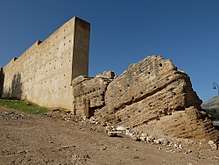
One of the most common types of construction in Morocco, especially for city walls, was rammed earth, an ancient building technique found across the Near East, Africa, and beyond.[51][52][53] It is also known as "pisé" (from French) or "tabia" (from Arabic).[2] The ramparts of Fes, Marrakesh, and Rabat, for example, were made with this process, even though some notable structures (like monumental gates) were also built in stone. It generally made use of local materials and was widely used thanks to its low cost and relative efficiency.[51] This material consisted of mud and soil of varying consistency (everything from smooth clay to rocky soil) usually mixed with other materials such as straw or lime to aid adhesion. The addition of lime also made the walls harder and more resistant overall, although this varied locally as some areas had soil which hardened well on its own while others did not.[2] (For example, the walls of Fes and nearby Meknes contain up to 47% lime versus around 17% in Marrakesh and 12% in Rabat.[54]) The technique is still in use today, though the composition and ratio of these materials has continued to change over time as some materials (like clay) have become relatively more costly than others (like gravel).[2][4]:80
The walls were built from bottom to top one level at a time. Workers pressed and packed in the materials into sections ranging from 50 and 70 cm in length that were each held together temporarily by wooden boards. Once the material was settled, the wooden restraints could be removed and the process was repeated on top of the previously completed level.[52][54] This process of initial wooden scaffolding often leaves traces in the form of multiple rows of little holes visible across the face of the walls.[4] In many cases walls were covered with a coating of lime, stucco, or other material to give them a smooth surface and to better protect the main structure.[2]
This type of construction required consistent maintenance and upkeep, as the materials are relatively permeable and are more easily eroded by rain over time; in parts of Morocco, (especially near the Sahara) kasbahs and other structures made with a less durable composition (typically lacking lime) can begin to crumble apart in less than a couple of decades after they've been abandoned.[2][55] As such, old structures of this type remain intact only insofar as they are continuously restored; some stretches of wall today appear brand new due to regular maintenance, while others are crumbling.
Brick and stone

In addition to rammed earth, brick and (especially in desert regions) mudbrick were also common types of materials for the construction of houses, civic architecture, and mosques.[3][56][57] Many medieval minarets, for example, are made in brick, in many cases covered with other materials for decoration.[3][56] Stone masonry was also used in many notable monuments, especially in the Almohad period. The monumental Almohad gates of Bab Agnaou, Bab er-Rouah, and the main gate of the Udayas Kasbah (Bab Oudaia) made extensive use of carved stone.[3][23] The major Almohad minarets of the same period demonstrate the relative variability in construction material and methods, depending on the region and the demands of the structure: the minaret of the Kutubiyya Mosque is built in rubble masonry using sandstone, the Giralda of Seville (in Spain) was made in local brick, the massive but unfinished Hassan Tower in Rabat was made in stone, and the minaret of the Kasbah Mosque in Marrakesh was made with a base of rubble stone and a main shaft of brick.[3]:209-211
Wood
.jpg)
Wood was also extensively used, but mostly for ceilings and other elements above eye level such as canopies and upper galleries. Many buildings such as mosques and mausoleums have sloped wood-frame ceilings, visually enhanced by the use of geometric patterns in their arrangement, sculpting, and painted decoration.[3] Many doorways, street fountains, and mosque entrances are also highlighted with sculpted wood canopies which were characteristic of Moroccan and Moorish architecture.[3] Especially from the Marinid period onward, sculpted wood became a major component of architectural decoration.[5][3]
Wood generally came from Moroccan cedar trees[28][2][58], still highly valued today, which once grew abundantly on mountain slopes across the country but are now partly endangered and limited to forests of the Middle Atlas.[59][60] Other types of wood were still occasionally used, however. The sculpted wood canopy of the Shrob ou Shouf Fountain in Marrakesh was made of palm wood, for example.[23]:128 The famous Minbar of the Kutubiyya Mosque, which was fabricated in Cordoba (Spain) before being shipped to Marrakesh, was made primarily of cedar wood but its marquetry decoration was enhanced with more exotic woods of different colors such as jujube and African blackwood.[61]
Other materials for decoration
.jpg)
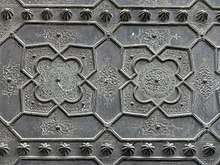
A very prominent and distinctive element of Moroccan and Moorish architecture is its heavy use of stucco for carved and sculpted decoration across walls and ceilings.[3][5] Stucco, which is relatively cheap and easily sculpted, was carved and painted with motifs from a large repertoire including floral and vegetal motifs (arabesques), geometric patterns, calligraphic compositions, and muqarnas forms.[5][3] (These were also common features in sculpted wood decoration.)
Tilework, particularly in the form of mosaic tilework called zellij, was a standard decorative element along lower walls and for the paving of floors. It consisted of hand-cut pieces of faience in different colours fitted together to form elaborate geometric motifs, often based on radiating star patterns.[5][3] Zellij made its appearance in the region during the 10th century and became widespread by the 14th century during the Marinid period.[5] It may have been inspired or derived from Byzantine mosaics and then adapted by Muslim craftsmen for faience tiles.[5] The tiles are first fabricated in glazed squares, typically 10 cm per side, then cut by hand into a variety of pre-established shapes (usually memorized by heart) necessary to form the overall pattern.[2] Although the exact patterns vary from case to case, the underlying principles have been constant for centuries and Moroccan craftsmen are still adept at making them today.[2]
Metal, particularly bronze and copper, was also used to decorate or protect certain elements. Notably, the doors of many medieval mosques and madrasas were covered with bronze or copper plating which was carved and chiseled with geometric, arabesque, and calligraphic motifs.[5] The oldest surviving bronze artworks in Moorish-Moroccan art, for example, are the 12th-century bronze fittings found on several doors of the Qarawiyyin Mosque in Fes.[62]
Types of structures
The following is a summary of the different major types and functions of buildings and architectural complexes found in historic Moroccan architecture.
Religious architecture
Mosques
_(2).jpg)
.jpg)
Mosques are the main place of worship in Islam. Muslims are called to prayer five times a day and participate in prayers together as a community, facing towards the qibla (direction of prayer). Every neighbourhood normally had one or many mosques in order to accommodate the spiritual needs of its residents. Historically, there was a distinction between regular mosques and "Friday mosques" or "grand mosques", which were larger and had a more important status by virtue of being the venue where the khutba (sermon) was delivered on Fridays.[21] Friday noon prayers were considered more important and were accompanied by preaching, and also had political and social importance as occasions where news and royal decrees were announced, as well as when the current ruler's name was mentioned. In the early Islamic era of Morocco, there was typically only one Friday mosque per city, but over time Friday mosques multiplied until it was common practice to have one in every neighbourhood or district of the city.[63][56] Mosques could also frequently be accompanied by other facilities which served the community.[56][26]
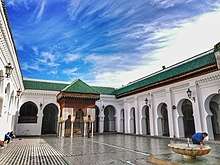
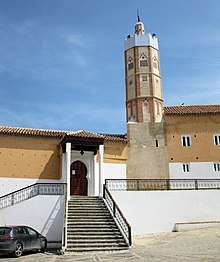
Mosque architecture in Morocco was heavily influenced from the beginning by major well-known mosques in Tunisia and al-Andalus (Muslim Spain and Portugal), two countries from which many Arab and Muslim immigrants to Morocco originated.[16] The Great Mosque of Kairouan and the Great Mosque of Cordoba, in particular, were models of mosque architecture.[3][7] Accordingly, most mosques in Morocco have roughly rectangular floor plans and follow the hypostyle format: they consist of a large prayer hall upheld and divided by rows of horseshoe arches running either parallel or perpendicular to the qibla wall (the wall towards which prayers faced). The qibla (direction of prayer) was always symbolized by a decorative niche or alcove in the qibla wall, known as a mihrab.[2] Next to the mihrab there was usually a symbolic pulpit known as a minbar. The mosque also normally included, close to entrance, a sahn (courtyard) which often had fountains or water basins to assist with ablutions. In early periods this courtyard was relatively minor in proportion to the rest of the mosque, but in later periods it became a progressively larger until it was equal in size to the prayer hall and sometimes larger.[28][56] Lastly, mosque buildings were distinguished by their minarets: towers from which the muezzin issues the call to prayer to the surrounding city. (This was historically done by the muezzin climbing to the top and projecting his voice over the rooftops, but nowadays the call is issued over modern megaphones installed on the tower.) Moroccan minarets traditionally have a square shaft and are arranged in two tiers: the main shaft, which makes up most of its height, and a much smaller secondary tower above this which is in turn topped by a finial of copper or brass spheres.[3][56] Some Moroccan minarets have octagonal shafts, though this is more characteristic of the northern parts of the country.[5] Inside the main shaft a staircase, and in other cases a ramp, ascends to the top of the minaret.[3][56]
Medieval Moroccan mosques also frequently followed the "T-type" model established in the Almohad period. In this model the aisle or "nave" between the arches running towards the mihrab (and perpendicular to the qibla wall) was wider than the others, as was also the aisle directly in front of and along the qibla wall (running parallel to the qibla wall); thus forming a "T"-shaped space in the floor plan of the mosque which was often accentuated by greater decoration (e.g. more elaborate arch shapes around it or decorative cupola ceilings at each end of the "T").[56][28][26]
The whole structure of a mosque was also orientated or aligned with the direction of prayer (qibla), such that mosques were sometimes orientated in a different direction from the rest of the buildings or streets around it.[64] This geographic alignment, however, varied greatly from period to period. Nowadays it is standard practice across the Muslim world that the direction of prayer is the direction of the shortest distance between oneself and the Kaaba in Mecca. In Morocco, this corresponds to a generally eastern orientation (varying slightly depending on your exact position).[65] However, in early Islamic periods there were other interpretations of what the qibla should be. In the western Islamic world (the Maghreb and al-Andalus), in particular, early mosques often had a southern orientation, as can be seen in major early mosques like the Great Mosque of Cordoba and the Qarawiyyin Mosque in Fes. This was based on a reported hadith of the Prophet Muhammad which stated that "what is between the east and west is a qibla", as well as on a popular view that mosques should not be aligned towards the Kaaba but rather that they should follow the cardinal orientation of the Kaaba itself (which is a rectangular structure with its own geometric axes), which is in turn aligned according to certain astronomical references (e.g. its minor axis is aligned with the sunrise of the summer solstice).[66][65][64]
Madrasas
.jpg)

The madrasa was an institution which originated in northeastern Iran by the early 11th century and was progressively adopted further west.[3][2] These establishments provided higher education and served to train Islamic scholars, particularly in Islamic law and jurisprudence (fiqh). The madrasa in the Sunni world was generally antithetical to more "heterodox" religious doctrines, including the doctrine espoused by the Almohad dynasty. As such, it only came to flourish in Morocco under the Marinid dynasty which succeeded the Almohads.[3] To the Marinids, madrasas also played a part in bolstering the political legitimacy of their dynasty. They used this patronage to encourage the loyalty of the country's influential but independent religious elites and also to portray themselves to the general population as protectors and promoters of orthodox Sunni Islam.[3][58] Finally, madrasas also played in important role in training the scholars and elites who operated the state bureaucracy.[58]
Madrasas also played a supporting role to major learning institutions like the Qarawiyyin Mosque, in part because, unlike the mosque, they provided accommodations for students who came from outside the city.[2]:137[4]:110 Many of these students were poor, seeking sufficient education to gain a higher position in their home towns, and the madrasas provided them with basic necessities such as lodging and bread.[21]:463 However, the madrasas were also teaching institutions in their own right and offered their own courses, with some Islamic scholars making their reputation by teaching at certain madrasas.[4]:141
Madrasas were generally centered around a main courtyard with a central fountain, off which other rooms could be accessed. Student living quarters were typically distributed on an upper floor around the courtyard. Many madrasas also included a prayer hall with a mihrab, though only the Bou Inania Madrasa of Fes officially functioned as a mosque and featured its own minaret. In the Marinid era, madrasas evolved to be lavishly decorated.[27][3]
Mausoleums and zawiyas

Most Muslim graves are traditionally simple and unadorned, but in North Africa the graves of important figures were often covered in a domed structure called a qubba (also spelled koubba). This was especially characteristic for the tombs of "saints" such as walis and marabouts: individuals who came to be venerated for their strong piety, reputed miracles, or other mystical attributes. Many of these existed within the wider category of Islamic mysticism known as Sufism.
Some of these tombs became the focus of entire religious complexes built around them, known as a zawiya (also spelled zaouia; Arabic: زاوية).[26][3][67] They typically included a mosque, school, and other charitable facilities.[3] Such religious establishments were major centers of Moroccan Sufism and grew in power and influence over the centuries, often associated with specific Sufi Brotherhoods or schools of thought.[26][64] The Saadian dynasty, for example, began as a military force associated with the zawiya and followers of Muhammad al-Jazuli, a major 15th-century Sufi scholar.[26][28] The Alaouites after them also sponsored many zawiyas across the country.[5][26] Some of the most important examples of zawiyas in Morocco include the Zawiya of Moulay Idris I near Meknes, the Zawiya of his son Moulay Idris II in Fes, and the tombs of the Seven Saints in Marrakesh.[26][5]
Civic architecture
Funduqs
.jpg)
A funduq (also spelled foundouk or fondouk; Arabic: فندق) was a caravanserai or commercial building which served as both an inn for merchants and a warehouse for their goods and merchandise.[3][2][64] In Morocco some funduqs also housed the workshops of local artisans.[21] As a result of this function, they also became centers for other commercial activities such as auctions and markets.[21] They typically consisted of a large central courtyard surrounded by a gallery, around which storage rooms and sleeping quarters were arranged, frequently over multiple floors. Some were relatively simple and plain, while others, like the Funduq al-Najjariyyin (or Fondouk Nejjarine) in Fes, were quite richly decorated.[5]
Hammams

Hammams (Arabic: حمّام) are public bathhouses which were ubiquitous in Muslim cities. Essentially derived from the Roman bathhouse model, they normally consisted of four main chambers: a changing room, from which one then moved on to a cold room, a warm room, and a hot room.[3]:215-216, 315-316 Heat and steam were generated by a hypocaust system which heated the floors. The furnace re-used natural organic materials (such as wood shavings, olive pits, or other organic waste byproducts) by burning them for fuel.[68] The smoke generated by this furnace helped with heating the floors while excess smoke was evacuated through chimneys. Of the different rooms, only the changing room was heavily decorated with zellij, stucco, or carved wood.[3]:316 The cold, warm, and hot rooms were usually vaulted or domed chambers without windows, designed to keep steam from escaping, but partially lit thanks to small holes above which were covered by ceramic or coloured glass.[3]:316
Public fountains
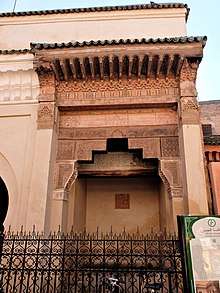
As in many Muslim cities, water was provided freely to the public through a number of street fountains, similar to sebils in the former Ottoman Empire. Some fountains were decorated with a canopy of sculpted wood or zellij tilework.[3]:410-413 Fountains were often attached to the outside of mosques, funduqs, and aristocratic mansions.[21][28] According to Leo Africanus, a traveler and chronicler in the 16th century, there were some 600 fountains in Fes alone.[21]:236 Well-known examples in Morocco include the Nejjarine Fountain in Fes, and the Shrob ou Shouf Fountain in Marrakesh, and the Mouassine Fountain attached to the mosque of the same name.[5][28]
Water supply infrastructure
Moroccan cities and towns were supplied with water through a number of different mechanisms. As elsewhere, most settlements were built near existing water sources such as rivers and oases. However, further engineering was necessary in order to supplement natural sources and in order to distribute the water across the city directly. In Fes, this was accomplished via a complex network of canals and channels which captured the waters of the Oued Fes (Fes River) and distributed them across the entire city. These water channels (most of them now hidden under buildings) supplied houses, gardens, fountains, and mosques, powered norias (waterwheels), and sustained certain industries such as the tanning (e.g. the famous Chouara Tannery).[69][57][21] Waterwheels were also used to lift water from these canals and into aqueducts to bring them even further, such as the enormous noria, with a diameter of 26 meters, built by the Marinids to supply their Royal Gardens to the north of Fes el-Jdid.[70]
In Marrakesh, located in a more arid environment, the city was supplied in large part by a system of khettaras, an ingenious and complex system by which an underground channel was dug under the slopes near the city until it reached the level of the phreatic zone.[64] This artificial underground channel was gently sloped to allow water to drain through it, but was sloped less steeply than the natural terrain so that it eventually emerged at the surface. In this way, the khettaras drew water from underground aquifers and brought them to the surface with the use of gravity alone. Once at the surface, the waters ran along canals and were stored in a cistern or water basin, from which they could then be redistributed across the city.[64] This system was created under the Almoravids (who founded the city) and further developed and maintained by their successors.[64]
Domestic architecture
Riads

A riad (sometimes spelled riyad; Arabic: رياض) is an interior garden found in many Moroccan mansions and palaces. It is normally rectangular and divided into four parts along its central axes, with a fountain at its middle.[64] Riad gardens probably originated in Persian architecture (where it is also known as chahar bagh) and became a prominent feature in Moorish palaces in Spain (such Madinat al-Zahra, the Aljaferia and the Alhambra).[64] In Morocco, they became especially widespread in the palaces and mansions of Marrakesh, where the combination of space and warm climate made them particularly appealing.[64] The term is nowadays applied in a broader way to traditional Moroccan houses that have been converted into hotels and tourist guesthouses.[71][72]
Houses

Traditional Moroccan houses were typically centered around a main courtyard, sometimes surrounded by a gallery, from which other rooms and sections branched off.[73][64] Courtyard houses have historical antecedents in the houses and villas of the Greco-Roman Mediterranean world and even earlier in the ancient Middle East.[64] Moroccan houses, even rich mansions, are usually completely unadorned on the outside, with all decoration concentrated on the inside. As with other types of structures, decoration included carved stucco, sculpted and painted wood, and zellij tilework.[73][64] A number of bourgeois mansions have survived across the country, mostly from the Alaouite era but some dating as far back as the Marinid or Saadian periods.[73][64]
Palaces
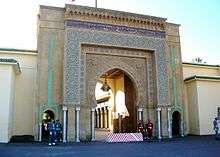
Sultans and caliphs, as well as the more powerful and wealthy government ministers in the 19th and 20th century, were able to build extensive palaces. The Dar al-Makhzen (meaning roughly "House/Abode of the Government") referred to the royal palace and center of government in a number of cities, such as the Dar al-Makhzen in Fes, Rabat, Tangier, or Marrakesh.[3][5][26] These palaces are still generally off-limit to most visitors today. However, royal palaces generally had a mechouar, a large walled square which acted as a ceremonial space or parade ground at the entrance of the palace. These squares were accessible to the public and formed the public facade of the ruler's abode, sometimes overlooked by monumental and well-decorated gates leading to the palace grounds (e.g. Bab al-Mansour in Meknes).[74][26][2] The mechouars of Fes el-Jdid are examples of these, as was the vast square known today as Place el-Hedim in Meknes. The palaces themselves typically consisted of many structures and pavilions arranged around a series of courtyards, pleasure gardens, and riads.[3][75] This resulted in palace complexes with a sprawling layout; in some cases this was a consequence of multiple phases of construction taking place in different periods. These palaces often also included a number of normally public facilities such as bathhouses and mosques, thus practically making them self-sufficient and self-contained royal cities.[74][26] Sultans also built additional outlying palaces and pavilions such as the Dar Batha in Fes, as well as vast gardens on the outskirts of their capital city such as the Agdal Garden in Marrakesh and the former Mosara Garden in Fes.[64][21][70]
In the 19th and early 20th centuries, grand viziers and other high officials of the government were able to accumulate enough power and wealth to build their own private palaces for themselves and their households.[26] Examples of these include the Bahia Palace of Ba Ahmed (which was later taken over by the sultan), the Dar al Bacha and Dar Si Said in Marrakesh, the Dar Moqri and Dar Glaoui in Fes, and the Dar Mnebbhi in Fes and its counterpart in Marrakesh. Other local warlords and magnates were also sometimes capable of building their own lavish palaces, such as the Palace of Raissouli in Asilah.[5]
Military architecture

City walls
Defensive city walls were generally built out of rammed earth[3] and consisted of a wall topped by a walkway for soldiers, reinforced at regular intervals by square bastion towers. These walls were characteristically crowned by merlons shaped like square blocks topped by pyramidal caps. Major examples of such fortifications still stand in Marrakesh, Fes, Rabat, and other cities.[64][5][70] The defensive walls constructed in Muslim al-Andalus also shared this general form, examples of which have survived in Cordoba, Seville, and Granada.[64]
City gates

As in medieval fortifications elsewhere in the world, Moroccan city walls were pierced with a number of gates to grant access in and out of the city. As these were often the weakest points of a defensive wall, they were usually were more heavily fortified than the surrounding wall. Most medieval Moroccan gates had a bent entrance: their passage made sharp right-angle turns once or multiple times in order to slow down any attackers.[75][76][64] They ranged from very plain in appearance to highly monumental and ornamental. Many of the most monumental gates still standing today were built in stone during the Almohad period, including Bab Agnaou in Marrakesh and the gate of the Udayas Kasbah in Rabat.[7][23] As the defensive function of city walls and gates became less relevant in the modern era, gates became more ornamental and symbolic structures, like the Bab Bou Jeloud gate built in Fes in 1913.[75]
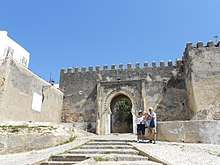
Kasbahs
The term Kasbah (Arabic: قَـصَـبَـة, romanized: qaṣabah) in Morocco generally refers to a fortified enclosure, ranging from small garrison forts to vast walled districts which functioned as the citadel and center of government in the city (such as the Kasbah of Marrakesh or the Kasbah of Tangier).[5][3][7] "Kasbah" can also refer to various fortresses or fortified mansions in the Atlas Mountains and the desert oases regions of Morocco, such as the Kasbah Telouet, Tamnougalt, or Kasbah Taourirt in Ouarzazate.[8]
Forts and other fortifications (borj, sqala, and ribat)
_d'Essaouira_-_Photo_de_Abdellatif_AMAJGAG_2.jpg)
A borj (Arabic: برج) generally referred to a single fort, tower, or bastion, such as the Borj Nord in Fes.[21][75] A sqala (Arabic: سقالة) was another type of bastion, often a seaside fortification with a platform for canons, like the Sqala of Essaouira or that of the Udayas Kasbah in Rabat.[77][78][5] A ribat (Arabic: رِبَـاط) usually referred to a countryside or frontier fortress ostensibly used by warriors fighting waging jihad on the edge of Islamic territory, though it also referred to a type of fortified "monastery" or spiritual retreat for Sufi adherents, not unlike a zawiya.[3] A notable example, from an architectural point of view, is the Ribat of Tit south of El Jadida, which was originally constructed by one family in the 12th century.[3] (Also notably, the name of the city of Rabat derives from its original name Ribat al-Fath[7].)
Agadirs

Agadirs were fortified granaries typically found in the desert, mountain, and oases regions of southern and eastern Morocco. They are one of the architectural types associated in particular with Berber architecture in North Africa.[8]
Architectural features

Arches, most often the horseshoe arch are used in almost every aspect of Moroccan housing whether it is doors, entrances, windows or niches.
Domes are often integrated with altars or commemorative monuments as well as modern villas.
The interior doors of villas are usually oversized and decorative. In contrast, very small doors are used in dars. Doors are often adorned with delicate metal work, carving or color.
In contrast with doors, windows in Moroccan architecture are often unremarkable. They are normally arched glass panes with fewer adornments compared to doors.
Mashrabiya is an Islamic dowel work, made by carving large wood partitions in elaborate geometric patterns. Its purpose is to conceal the women from the visitor’s prying eyes according to Islamic tradition.
The fountain is a conspicuous feature in every house, often made of marble or cement. It is built in the heart of the courtyard, living room or guest room.
Elements of classic Moroccan interiors
Woodwork
Woodwork can be found in both urbanized and more traditional areas of Morocco. The woodwork serves as the main finishing. This intricate woodwork can be found on various surfaces of buildings especially the interiors, such as wall, ceiling window, gallery and balcony. The wood itself does not need to be finished or painted after the long process of delicate carving.[79]
Plaster
The plaster used for sculpting is called "gabs" or "jybs" in Moroccan, with the gypsum extracted abundantly from quarries in Safi, Asni, Meknes and Ouazzane. Tadelakt, qadad, and non-waterproof plasters are used. They may be polished smooth or elaborately carved into yeseria.
Metalwork
Copper, bronze, iron and brass are materials commonly used for studs, door knobs, window frames and door frames as well as room partitions.
Ceramics
A wide variety of ceramics is produced in Morocco. The painted and glazed ceramics are used for architectural work and tableware. Some are commonly used as roof tiling and decorative zellige tilework. The process of tiling, arranging and cutting them requires expertise in order to deliver a detailed piece of work.[80]
Color palettes
Morocco is known for its vivid and colorful design. However, the diversity of colors that are included in the design all holds different connotations.[81]
| Color | Color Range | Symbolism | Usage |
|---|---|---|---|
| Blue | Greenish Turquoise, Fresh Fez Blue, Electric Majorelle Blue, Dark and Light Indigos | Sky, Heaven, Water, Planet Mercury. Muslims believed the color could protect them from evil’s eyes, also believe that it can enhance one medical and cosmetic condition. | Tiling, Floor, Textiles, Door and window frames, Garden furniture |
| White | White, Ivory, Beige | Cleanness, Good luck, Beauty, Femininity. Based on Muslim belief these colors connote moral qualities. | Commonly found in textiles using different materials. As a complement to other Moroccan patterns that use darker colors. |
| Red | Salmon, Rosy Pink, Fuchsia, Apple Red, Brick Red, Carmine, Violet, Bordeaux | Female, Sexuality, Fertility, Childbirth which relates to happy marriage. Some said it also represent the planet Mars. | Walls, Roof tiles, Carpets, Pottery |
| Black | Black, Soft Black, Smoke, Brown | Though the scheme is popularly used, however it holds a negative connotation. Believe that these colors are likely to bring bad luck and grief. | Mosaic, Carpets, Textiles. However it is use frequently in various items since it is a base color in their design. |
| Green | Bottle Green, Blue Green, Grass Green | The color relates with the Muslim interpretation of heaven presumably because it is in between the reddish hell and the blue heaven based on their belief. | Pottery, Tiling, Ceiling Painting, Furniture |
| Yellow | Gold, Lemon Yellow, Dark Yellow, Orange Yellow, Orange | Gold, Wealth, Sun. Believed that these colors would protect them from evil. | Textiles and embroidery, Tiling, Painted decoration on furniture, Leather products, Carpets |
_(14779894734).jpg) Bab Agnaou in Marrakesh, 12th century Almohad style gate to the city (southern gate)
Bab Agnaou in Marrakesh, 12th century Almohad style gate to the city (southern gate)- Bou Inania Madrasa in Meknes, showing the classic elements of Moroccan 12th century style
 Ben Youssef Madrasa in Marrakesh, Almoravid 12th century
Ben Youssef Madrasa in Marrakesh, Almoravid 12th century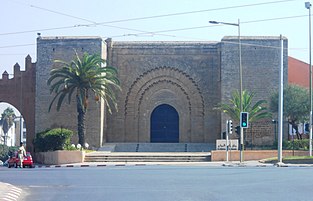 Bab er-Rouah in Rabat built by the Almohad
Bab er-Rouah in Rabat built by the Almohad Tadelakt yeseria carving in a riad in Marrakesh, Morocco
Tadelakt yeseria carving in a riad in Marrakesh, Morocco Modern use of traditional Moroccan decor at the gates of the Royal Palace in Fes, displaying delicate metalwork and ceramic art.
Modern use of traditional Moroccan decor at the gates of the Royal Palace in Fes, displaying delicate metalwork and ceramic art.
References
- Rivet, Daniel (2012). Histoire du Maroc: de Moulay Idrîs à Mohammed VI. Paris: Fayard. ISBN 9782213638478.
- Parker, Richard (1981). A practical guide to Islamic Monuments in Morocco. Charlottesville, VA: The Baraka Press.
- Marçais, Georges (1954). L'architecture musulmane d'Occident. Paris: Arts et métiers graphiques.
- Gaudio, Attilio (1982). Fès: Joyau de la civilisation islamique. Paris: Les Presse de l'UNESCO: Nouvelles Éditions Latines. ISBN 2723301591.
- Touri, Abdelaziz; Benaboud, Mhammad; Boujibar El-Khatib, Naïma; Lakhdar, Kamal; Mezzine, Mohamed (2010). Le Maroc andalou : à la découverte d'un art de vivre (2 ed.). Ministère des Affaires Culturelles du Royaume du Maroc & Museum With No Frontiers. ISBN 978-3902782311.
- Barrucand, Marianne; Bednorz, Achim (1992). Moorish architecture in Andalusia. Taschen. ISBN 3822876348.
- Bennison, Amira K. (2016). The Almoravid and Almohad Empires. Edinburgh University Press.
- L. Golvin, « Architecture berbère », Encyclopédie berbère [online], 6 (1989), document A264, published online on December 1, 2012, accessed on April 10, 2020. URL : http://journals.openedition.org/encyclopedieberbere/2582
- Centre, UNESCO World Heritage. "Ksar of Ait-Ben-Haddou". UNESCO World Heritage Centre. Retrieved 2020-04-16.
- Wright, Gwendolyn (1991). The Politics of Design in French Colonial Urbanism. University of Chicago Press.
- The Rough Guide to Morocco (12th ed.). Rough Guides. 2019.
- "Hassan II Mosque". Archnet. Retrieved 2020-06-09.
- "Desert Blooms: The Contemporary Architecture of Morocco - Architizer Journal". Journal. 2019-07-02. Retrieved 2020-06-09.
- "Modern Morocco: Building a New Vernacular". ArchDaily. 2019-11-26. Retrieved 2020-06-09.
- Brett, Michael; Fentress, Elizabeth (1996). The Berbers. Blackwell. ISBN 0631168524.
- Abun-Nasr, Jamil (1987). A history of the Maghrib in the Islamic period. Cambridge: Cambridge University Press. ISBN 0521337674.
- Hattstein, Markus and Delius, Peter (eds.), 2011, Islam: Art and Architecture. h.f.ullmann.
- Richard Ettinghausen, Richard; Grabar, Oleg; Jenkins-Madina, Marilyn (2003). The Art and Architecture of Islam: 650-1250 (2nd ed.). Yale University Press.
- Keshani, Hussein (2008). "Art". In Rippin, Andrew (ed.). The Islamic World. London: Routledge. pp. 421–443.
- Bierman, Irene A.; al‐Asad, Mohammad (2009). "Architecture". In Bloom, Jonathan M.; Blair, Sheila S. (eds.). The Grove Encyclopedia of Islamic Art and Architecture. New York: Oxford University Press.
- Le Tourneau, Roger (1949). Fès avant le protectorat: étude économique et sociale d'une ville de l'occident musulman. Casablanca: Société Marocaine de Librairie et d'Édition.
- Terrasse, Henri (1968). La Mosquée al-Qaraouiyin à Fès; avec une étude de Gaston Deverdun sur les inscriptions historiques de la mosquée. Paris: Librairie C. Klincksieck.
- Salmon, Xavier (2018). Maroc Almoravide et Almohade: Architecture et décors au temps des conquérants, 1055-1269. Paris: LienArt.
- Basset, Henri; Terrasse, Henri (1932). Sanctuaires et forteresses almohades. Paris: Larose.
- Tabbaa, Yasser (2008). "Andalusian roots and Abbasid homage in the Qubbat al-Barudiyyin in Marrakesh". Muqarnas. 25: 133–146.
- Deverdun, Gaston (1959). Marrakech: Des origines à 1912. Rabat: Éditions Techniques Nord-Africaines.
- Kubisch, Natascha (2011). "Maghreb - Architecture" in Hattstein, Markus and Delius, Peter (eds.) Islam: Art and Architecture. h.f.ullmann.
- Salmon, Xavier (2016). Marrakech: Splendeurs saadiennes: 1550-1650. Paris: LienArt. ISBN 9782359061826.
- "Opinion: "Casablanca presents one of the best models of modernism"". Dezeen. 2018-05-17. Retrieved 2020-06-09.
- Planet, Lonely. "Architecture in Morocco". Lonely Planet. Retrieved 2020-06-09.
- "Art Deco Architecture in Casablanca - Attraction | Frommer's". www.frommers.com. Retrieved 2020-06-09.
- Blondeau, Mathilde; Ouzzani, Kenza Joundy (2016). Casablanca courts-circuits. ISBN 978-9954-37-750-5. OCLC 1135744090.
- "Gran Teatro Cervantes". Archnet. Retrieved 2020-06-09.
- "Bank al-Maghrib, Agence Centrale". Archnet. Retrieved 2020-06-09.
- "Poste Maroc | Archnet". archnet.org. Retrieved 2020-06-09.
- "Rough Guides - Sidi Ifni". Rough Guides. Retrieved 2020-06-09.
- "Mohamed V Mausoleum | Mausoleum Mohammed V". Archnet. Retrieved 2020-06-09.
- "Railway Station (Marrakech)". Archnet. Retrieved 2020-06-09.
- "Marrakech-Menara Airport Extension/ E2A Architecture |". www.archidatum.com. Retrieved 2020-06-09.
- Eliason, Margot (2019-07-18). "Kenitra Train Station Wins International Architecture Prize". Morocco World News. Retrieved 2020-06-09.
- "silvio d'ascia architecture covers high-speed train station in traditional arabian pattern in morocco". designboom | architecture & design magazine. 2019-11-20. Retrieved 2020-06-09.
- "Casablanca Finance City Tower by Morphosis". www.architecturalrecord.com. Retrieved 2020-06-09.
- "Zaha Hadid Leaves Behind a Masterpiece (Theatre) in Rabat, Morocco". Redshift EN. 2019-04-04. Retrieved 2020-06-09.
- "Grand Théatre de Rabat – Zaha Hadid Architects". Retrieved 2020-06-09.
- Raffaelli, Giuliana; Robles Marín, Pedro; Guerrera, Francesco; Martín Martín, Manuel; Alcalá-García, Francisco Javier; Amadori, Maria Letizia; Asebriy, Lahcen; El Amrani, Iz-Edine; Tejera de León, Julian (June 2016). "Archaeometric study of a typical medieval fortified granary (Amtoudi Agadir, Anti-Atlas Chain, southern Morocco): a key case for the maintenance and restoration of historical monuments". Italian Journal of Geosciences. 135 (2): 280–299. doi:10.3301/IJG.2015.25. hdl:10045/64989.
- Montague, M. (2012), "Marrakesh by design: Decorating with all the colors, patterns, and magic of Morocco", Artisan, New York
- The Rough Guide to Dubai. Rough Guides UK. Penguin. 2016-11-15. p. 266. ISBN 978-0-2412-9865-7.
- Garret, Pascal (2002). "La fabrique publique de l'espace public confrontée aux intérêts privés. Lyautey, Prost et les "bâtisseurs" de Casablanca". Géocarrefour. 77 (3): 245–254. doi:10.3406/geoca.2002.2749.
- "Casablanca: L'histoire à travers les plans d'aménagement". L'Economiste (in French). 1999-02-17. Retrieved 2020-04-19.
- Tribillon, Jean-François. "Le dahir de 1914 et l'urbanisme au Maroc : permanence juridico-foncière et plasticité politique". Le carnet du Centre Jacques Berque (in French). Retrieved 2020-04-19.
- Futura. "Pisé". Futura (in French). Retrieved 2020-01-08.
- "Pisé", in The Penguin Dictionary of Architecture and Landscape Architecture, 5th edition (1998). p.439
- Jaquin, P. (2012). "History of earth building techniques". In Hall, Matthew R.; Lindsay, Rick; Krayenhoff, Meror (eds.). Modern Earth Buildings: Materials, Engineering, Constructions and Applications. Woodhead Publishing. p. 314.
- "Matériaux de construction traditionnels : Un bilan des recherches et des expériences". L'Economiste (in French). 1992-06-25. Retrieved 2018-02-10.
- The Rough Guide to Morocco (11 ed.). London: Rough Guides. 2016. p. 390. ISBN 9780241236680.
- Maslow, Boris (1937). Les mosquées de Fès et du nord du Maroc. Paris: Éditions d'art et d'histoire.
- Marcos Cobaleda, Maria; Villalba Sola, Dolores (2018). "Transformations in medieval Fez: Almoravid hydraulic system and changes in the Almohad walls". The Journal of North African Studies. 23 (4): 591–623.
- Lintz, Yannick; Déléry, Claire; Tuil Leonetti, Bulle (2014). Maroc médiéval: Un empire de l'Afrique à l'Espagne. Paris: Louvre éditions. ISBN 9782350314907.
- "Morocco's majestic cedars threatened by climate change". phys.org. Retrieved 2020-06-08.
- "Morocco's vulnerable cedar trees are being cut down illegally". The France 24 Observers. Retrieved 2020-06-08.
- Bloom, Jonathan; Toufiq, Ahmed; Carboni, Stefano; Soultanian, Jack; Wilmering, Antoine M.; Minor, Mark D.; Zawacki, Andrew; Hbibi, El Mostafa (1998). The Minbar from the Kutubiyya Mosque. The Metropolitan Museum of Art, New York; Ediciones El Viso, S.A., Madrid; Ministère des Affaires Culturelles, Royaume du Maroc.
- Terrasse, Henri (1968). La Mosquée al-Qaraouiyin à Fès; avec une étude de Gaston Deverdun sur les inscriptions historiques de la mosquée. Paris: Librairie C. Klincksieck.
- Terrasse, Henri (1964). "La mosquée almohade de Bou Jeloud à Fès". Al-Andalus. 29 (2): 355–363.
- Wilbaux, Quentin (2001). La médina de Marrakech: Formation des espaces urbains d'une ancienne capitale du Maroc. Paris: L'Harmattan. ISBN 2747523888.
- Bonine, Michael E. (1990). "The Sacred Direction and City Structure: A Preliminary Analysis of the Islamic Cities of Morocco". Muqarnas. 7: 50–72.
- King, David A. (1995). "The Orientation of Medieval Islamic Religious Architecture and Cities". Journal for the History of Astronomy. 26 (3): 253–274.
- Skali, Faouzi (2007). Saints et sanctuaires de Fés. Marsam Editions.
- Raftani, Kamal; Radoine, Hassan (2008). "The Architecture of the Hammams of Fez, Morocco". Archnet-IJAR, International Journal of Architectural Research. 2 (3): 56–68.
- Madani, Tariq (1999). "Le réseau hydraulique de la ville de Fès". Archéologie islamique. 8–9: 119–142.
- Bressolette, Henri; Delaroziere, Jean (1983). "Fès-Jdid de sa fondation en 1276 au milieu du XXe siècle". Hespéris-Tamuda: 245–318.
- "Accommodation in Morocco | Where to stay in Morocco". Rough Guides. Retrieved 2020-05-31.
- Planet, Lonely. "Sleeping in Morocco". Lonely Planet. Retrieved 2020-05-31.
- Revault, Jacques; Golvin, Lucien; Amahan, Ali (1985). Palais et demeures de Fès. Éditions du Centre national de la recherche scientifique.
- Aouchar, Amina (2005). Fès, Meknès. Flammarion. pp. 210–211.
- Métalsi, Mohamed (2003). Fès: La ville essentielle. Paris: ACR Édition Internationale. ISBN 978-2867701528.
- Allain, Charles; Deverdun, Gaston (1957). "Les portes anciennes de Marrakech". Hespéris. 44: 85–126.
- "Qantara - Sqala of the port of Essaouira". www.qantara-med.org. Retrieved 2020-06-08.
- "Sqala du port ( Sqala Al Marssa )". Inventaire et Documentation du Patrimoine Culturel du Maroc (in French). Retrieved 2020-06-08.
- Jereb, J. (1996). Arts & crafts of Morocco. San Francisco: Chronicle Books.
- Aboufadil, Y., Thalal, A., & Raghni, M. (2013). "Symmetry groups of Moroccan geometric woodwork patterns". Journal of Applied Crystallography, 46, 1–8.
- Montague, M. (2012). Marrakesh by design: Decorating with all the colors, patterns, and magic of Morocco. New York: Artisan.
.jpg)




.jpeg)